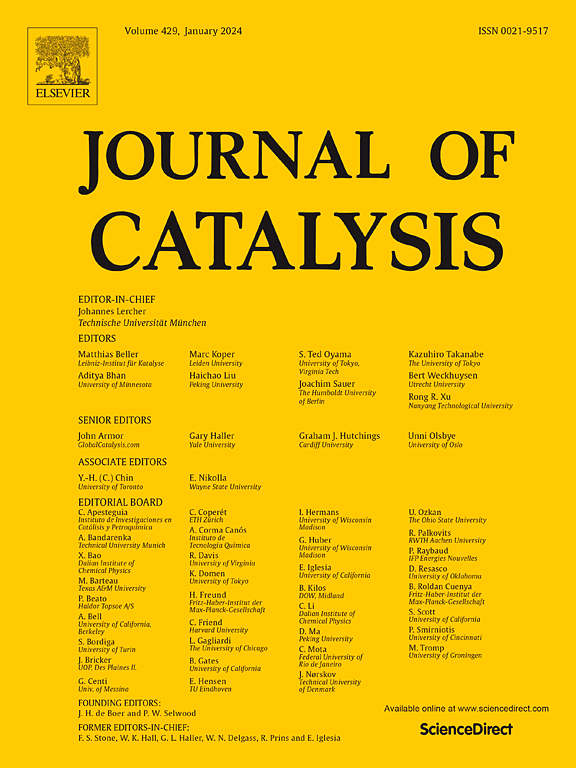Towards the computational design of single atom alloys for methane to ethylene conversion
IF 6.5
1区 化学
Q2 CHEMISTRY, PHYSICAL
引用次数: 0
Abstract
Direct conversion of methane to value-added chemicals has been a longstanding challenge in leveraging abundant natural gas resources due to unfavorable C–H bond activation and coke formation. We recently evaluated stability and reactivity of single atom alloys (SAAs) formed by atomically doping 3d-5d transition metals on Cu(111) as catalysts for direct methane conversion to C2 hydrocarbons using density functional theory calculations. Here, to further develop catalyst design principles for this chemistry, we systematically evaluate kinetics of methane dehydrogenation and C–C coupling steps on ten promising Cu(111)-based SAAs and unearth descriptors that correlate with catalyst activity and selectivity. Our results show that ethylene formation is kinetically favored over ethane formation across all SAAs studied. Notably, catalytic activity of SAAs highly correlates with their selectivity for direct methane conversion to C2 products, highlighting the synergy between dopant and host metal in enhancing methane activation and preference towards C–C coupling. In addition, we identify C2H4 adsorption energy as an effective descriptor that guides the SAA reactivity for methane activation to ethylene. Combining all analyses, we discover that iridium dispersed on copper (Ir/Cu) SAA stands out as a highly active and selective catalyst for methane to ethylene conversion. These findings pave the way for high-throughput screening of a vast SAA chemical space for the chemistry of methane transformation.

甲烷制乙烯单原子合金的计算设计
由于不利的碳氢键活化和焦炭形成,在利用丰富的天然气资源时,将甲烷直接转化为增值化学品一直是一个长期的挑战。我们最近用密度泛函理论计算评估了Cu(111)上原子掺杂3d-5d过渡金属形成的单原子合金(SAAs)作为甲烷直接转化为C2烃的催化剂的稳定性和反应性。在这里,为了进一步发展该化学的催化剂设计原则,我们系统地评估了10个有前途的Cu(111)基SAAs上甲烷脱氢和C-C偶联步骤的动力学,并发现了与催化剂活性和选择性相关的描述符。我们的研究结果表明,乙烯的形成在动力学上比乙烷的形成更有利。值得注意的是,SAAs的催化活性与其对甲烷直接转化为C2产物的选择性高度相关,这突出了掺杂剂和宿主金属在增强甲烷活化方面的协同作用,以及对C-C偶联的偏好。此外,我们发现C2H4吸附能是指导甲烷活化到乙烯的SAA反应活性的有效描述符。综合所有分析,我们发现分散在铜(Ir/Cu) SAA上的铱是甲烷转化为乙烯的高活性和选择性催化剂。这些发现为高通量筛选甲烷转化化学的巨大SAA化学空间铺平了道路。
本文章由计算机程序翻译,如有差异,请以英文原文为准。
求助全文
约1分钟内获得全文
求助全文
来源期刊

Journal of Catalysis
工程技术-工程:化工
CiteScore
12.30
自引率
5.50%
发文量
447
审稿时长
31 days
期刊介绍:
The Journal of Catalysis publishes scholarly articles on both heterogeneous and homogeneous catalysis, covering a wide range of chemical transformations. These include various types of catalysis, such as those mediated by photons, plasmons, and electrons. The focus of the studies is to understand the relationship between catalytic function and the underlying chemical properties of surfaces and metal complexes.
The articles in the journal offer innovative concepts and explore the synthesis and kinetics of inorganic solids and homogeneous complexes. Furthermore, they discuss spectroscopic techniques for characterizing catalysts, investigate the interaction of probes and reacting species with catalysts, and employ theoretical methods.
The research presented in the journal should have direct relevance to the field of catalytic processes, addressing either fundamental aspects or applications of catalysis.
 求助内容:
求助内容: 应助结果提醒方式:
应助结果提醒方式:


